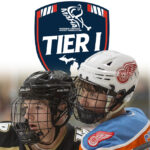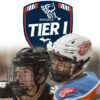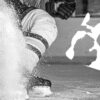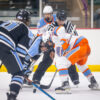
Charlie Webb is the owner of Mitten Sports, a professional grade skate-sharpening shop inside Farmington Hills Ice Arena. (Photo by Michael Caples/Great Lakes Skate)
By Charlie Webb –
Hockey has barriers to entry that most sports do not have to deal with, unfortunately.
One that may not be as obvious to even well-versed hockey people, however, involves those two little strips of steel that a new hockey player has to learn how to stand on.
It’s going to be hard enough, which is why when they take their first steps onto the ice, we should make sure their skates are going to be a help, not a hindrance.
Did you know that a new pair of hockey skates is not usable right out of the box? Even the tiniest of sizes for the smallest of new players? Sure, it is fair to expect that an elite hockey player will immediately take their new CCM or Bauer skates right to their favorite skate sharpening service, but for new hockey families, it’s too bad that the major equipment manufacturers can’t ship their entry-level pairs out to retailers and customers without a decent sharpening.
This is even more important to remember and also communicate to friends new to the game as ordering skates online becomes more and more commonplace and people never speak with a sales associate during the purchasing process.
There’s a pretty good chance that a used pair of skates is in a similar state of needing a sharpen. If you buy skates from Play It Again, a used gear swap at a rink, Facebook marketplace, or you even just end up with some hand-me-downs, get them checked out by a person like myself before putting them on your future Dylan Larkin or Megan Keller. You have no idea how many times those skates were used since their last sharpen, or even worse, what materials those skates may have walked on; this is a great time to remind everyone that you should never, ever let a pair of skates walk across cement or wood floors or anything that’s not the rubberized floors of a hockey rink.
While secondhand skates are probably dull, brand-new skates are just all over the map, really. The bottom of a skate blade, when properly sharpened, is supposed to look like a semi-circle was cut into the steel. When new skates are brought into my shop, sometimes the blades are completely flat, while other times it’s even a semi-circle in the wrong direction. Each company ends up with something different out-of-the-box, and that’s why it’s important to get your skates tuned up by a professional before taking the ice.
The semi-circle mentioned in the previous paragraph is the most important piece of equipment to any hockey player, whether they are skating for the first time or the one millionth. Your skate blade is what allows you to propel yourself across a frozen sheet of ice, and, especially important for new hockey players, it is what helps you stand upright on said slippery sheet. Without that semi-circle hollowed into the blade, it’s not grabbing or sticking into the ice. Walking across the ice in tennis shoes is bad enough – imagine if you were trying to do so while standing on a four millimeter-wide stick.
Likewise, imagine trying to walk on that four millimeter-wide stick and it’s crooked and leaning in one direction. If the skates were not sharpened properly – if the skate blade is not level – having only one properly functioning edge for a learn-to-skater is just as detrimental as not having any sharp edges.
Sure, it may be hard to tell if a new hockey player falling over is the fault of the player or the fault of the skates. You’re going to fall when you’re learning how to skate, there’s no getting around it. It’s one of the beautiful things about our sport – you literally are learning that when you fall, you get back up and you try it again.
However, if you see that while your hockey player is standing, their skates slide right out from under them, that’s a skate issue. If you get the newbie upright, there should be enough bite in the skate blade’s contact with the ice to keep them upright. If it looks like they’re wearing skis and those skis are going in different directions out of nowhere, examine the skate blades.
Off the ice, there are a few different things you can do to see if your skates need a sharpening, too. A visual test can at least let you see if there’s a hollow on the skate blade – that nice semi-circle we’ve been talking so much about. If you want to check to see if the edges are balanced, you can hold the skate upside down and place a coin or something else flat on the blade to see if everything’s even. You can also look for discolorations on the skate blade, which would be a sign of a poor sharpening. If the skate sharpener pressed the blade to the sharpening stone too aggressively you can see burning marks – a darker brownish red – which can mess with the edges or the overall consistency of the sharpening. If there are spots on the blade that are a lighter color than the rest, that means that spots were missed during the sharpening process. The color on the bottom of the blade should be one of consistency.
So you got the new hockey player’s skates sharpened, they loved their first time on the ice, and they’re heading back for more. Skate maintenance first? Nope, provided they didn’t walk on concrete or anything of the sort, you’re good to go for a while. A general rule of thumb is that skates should be sharpened for every six to eight hours of ice time, but with learn-to-play and younger age groups, you can go longer than that. Make sure the skate blades are protected when they are put back in the player’s bag or trunk or garage, and make sure they are dried off, too.
In future articles there will be more discussions on skate maintenance, what type of sharpening you should have on your skate, what ‘profiling’ means, and more. For now, however, I wanted to make sure that new hockey players and parents are aware of the importance of having sharpened skates when learning how to play.
Figuring out how to stand and skate on the ice is a challenge. Don’t make it harder than it has to be. Find a trusted source for your skate sharpening, and give you new hockey player a helping hand before they have even taken that magical first step onto the ice.
Good luck, and welcome to hockey!
Charlie Webb is the owner of Mitten Sports, a professional grade skate-sharpening shop in Farmington Hills, Mich., and a member of Skate Sharpening University, a worldwide group of skate sharpening professionals striving for more personalized and specialized service for all types of skaters.










